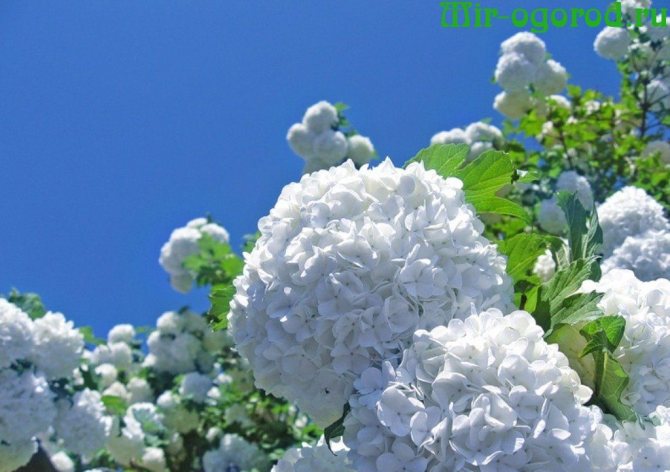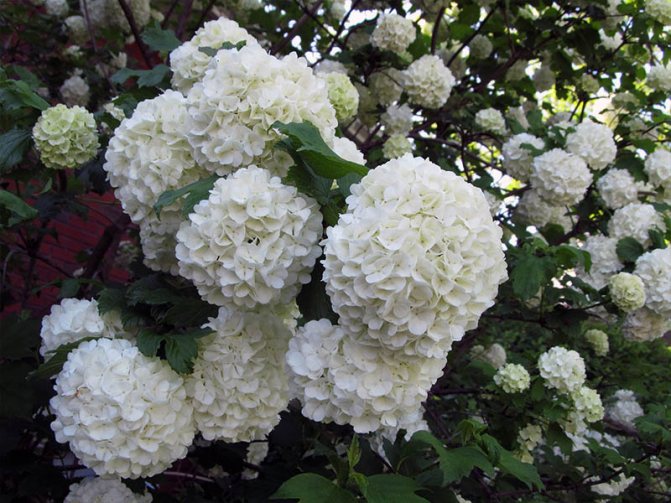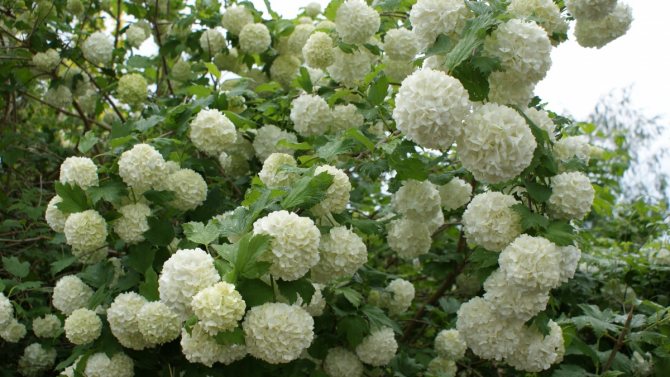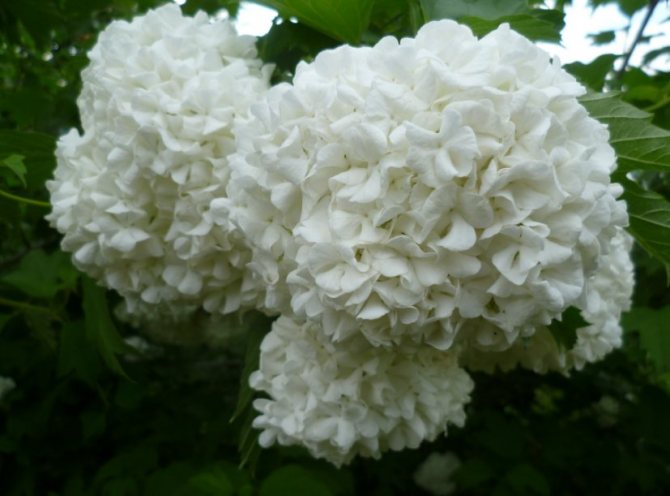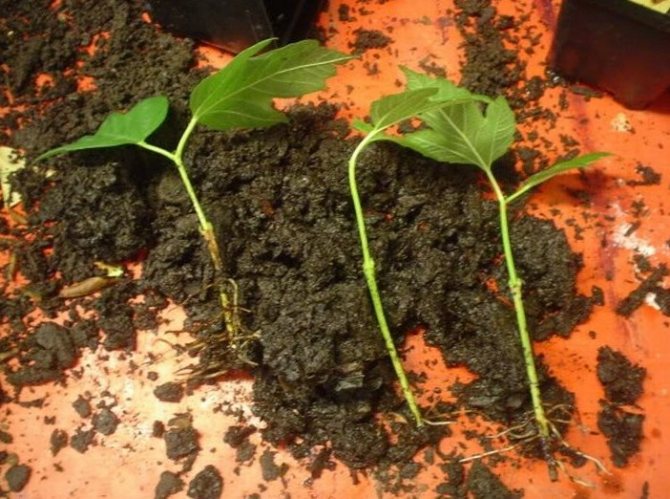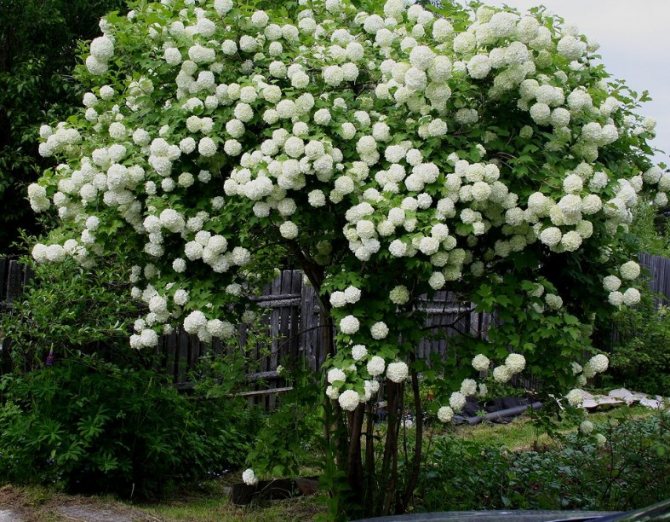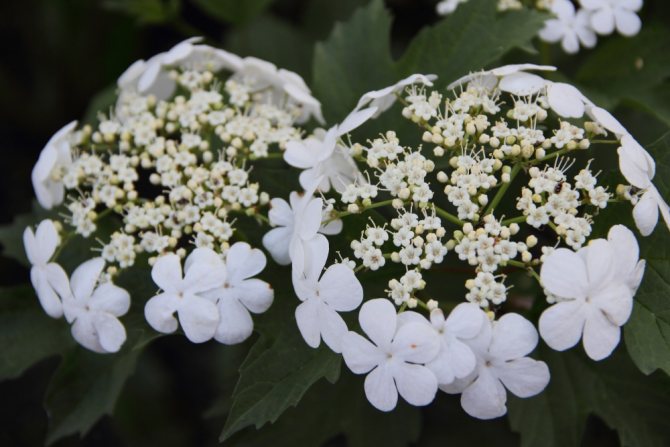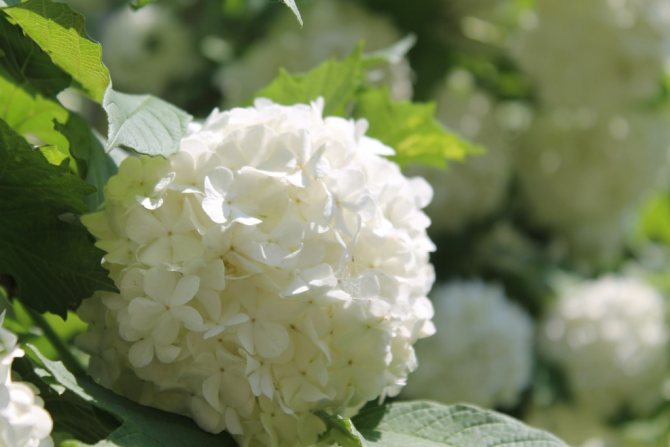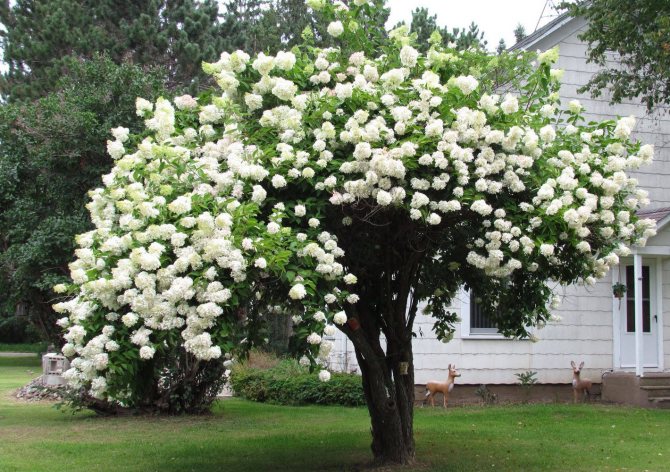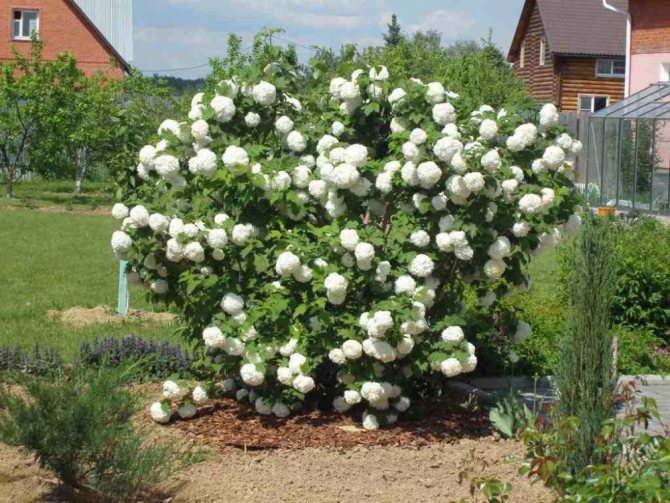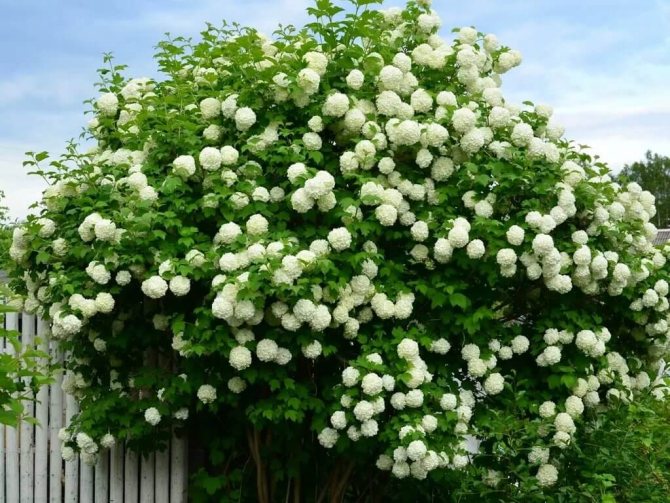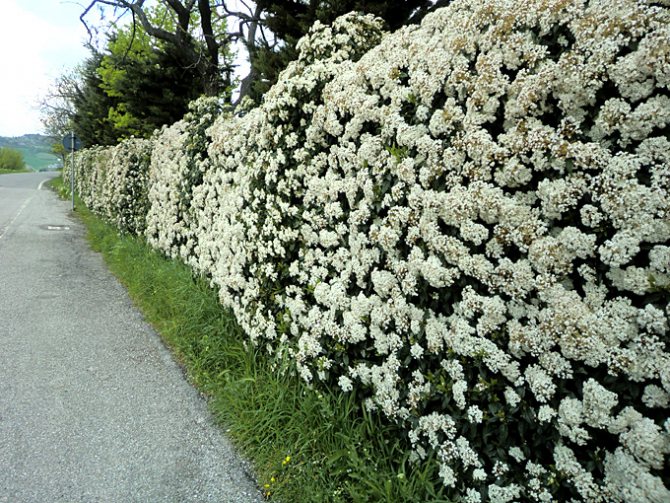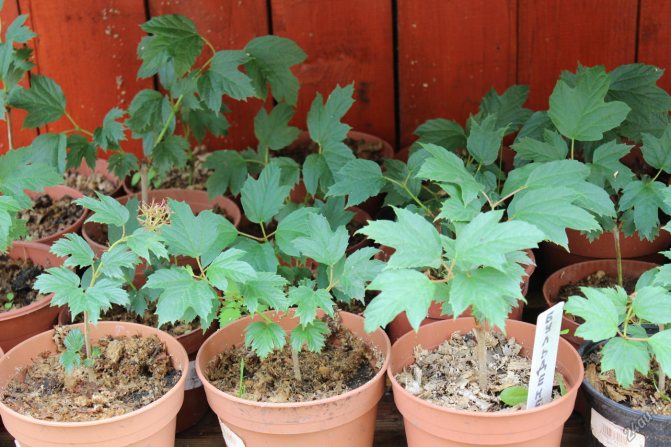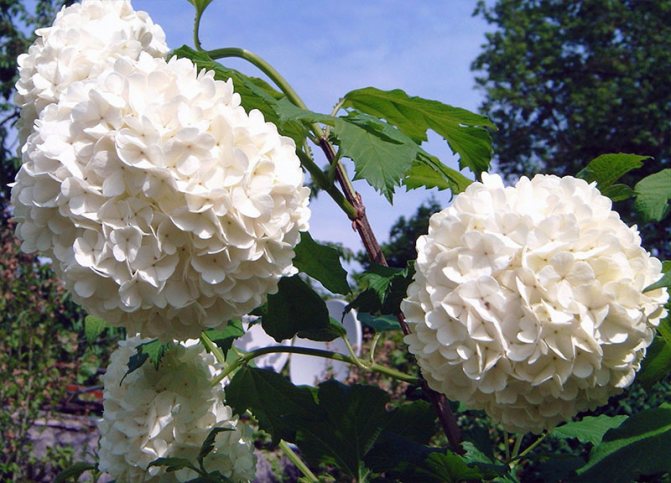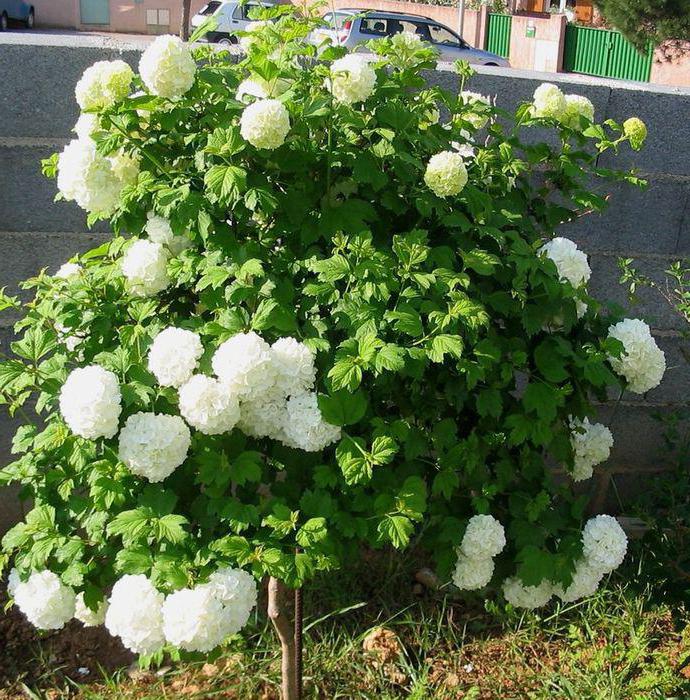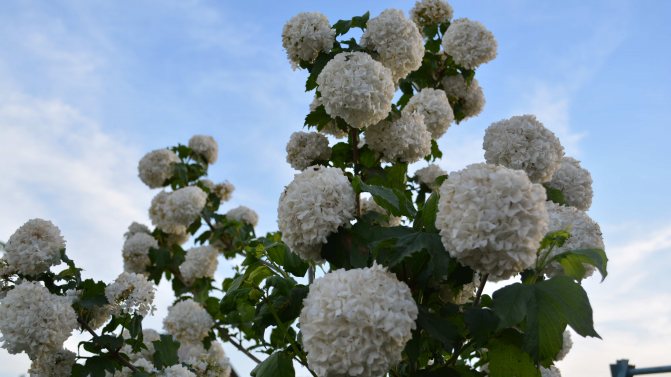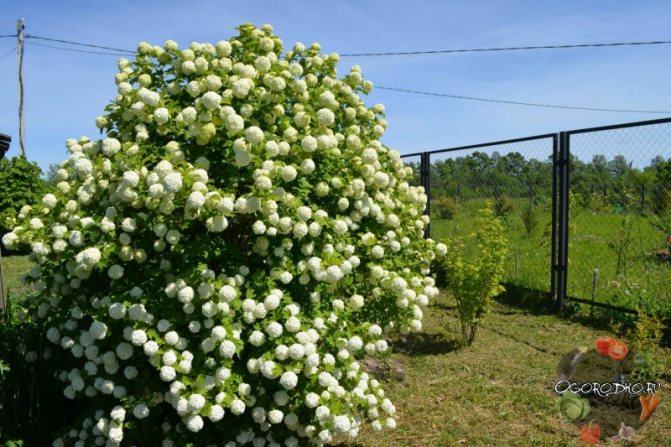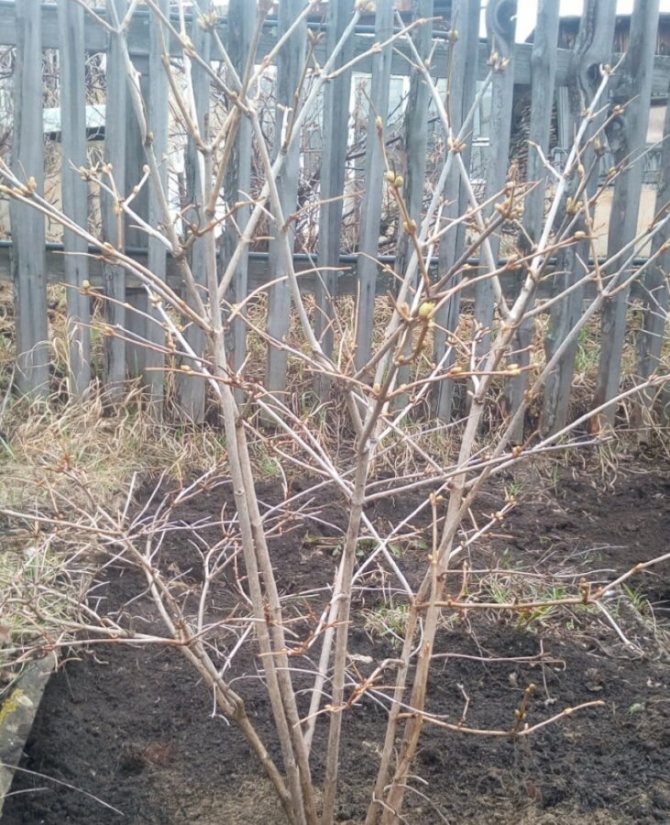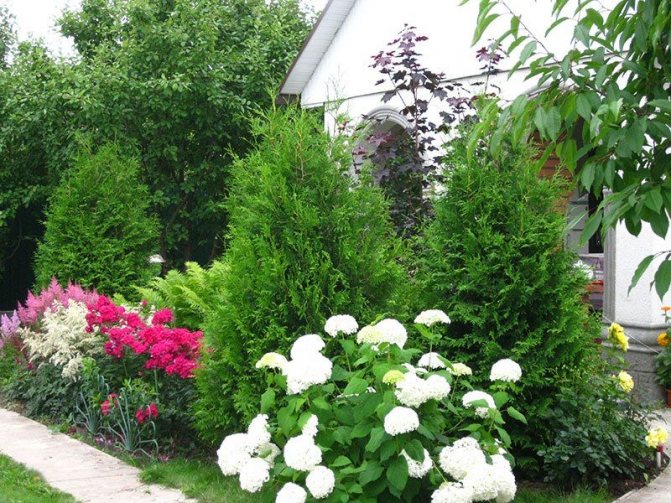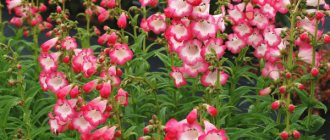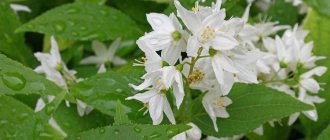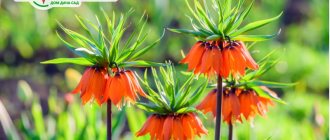Viburnum opulus L. Roseum, synonym for Viburnum opulus Sterilis) is a sterile variety of Viburnum Opulus.
Buldenezh is one of the most popular and oldest ornamental trees and shrubs - the variety has been known in culture since 1594.
Gardeners highly appreciate both the high decorativeness of the viburnum buldenezh and the ease of care. Growing this extremely beautiful shrub after planting does not require any special knowledge and does not take long.
Photo and description of viburnum buldenezh
This variety is a large, rounded deciduous shrub, reaching 2.5-3 meters in height. Its greatest decoration is its snow-white flowers in the form of large, heavy globular inflorescences, similar to hydrangeas. That is why the French name “Boule de Neige” is translated as “snow globe”.
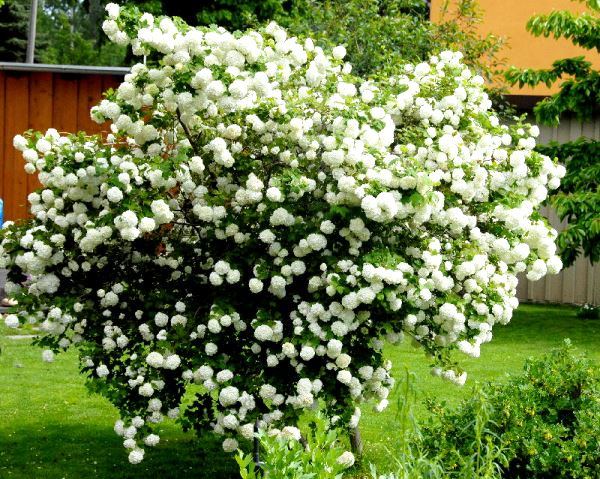
It blooms very profusely at the turn of May and June for 18-20 days. Only when they bloom, the flowers are greenish, then they become completely white, and when they fade, they acquire a pink tint.
The flowers contrast effectively with the green foliage, which turns orange and crimson in autumn. The variety is sterile, so you won't see any berries near the viburnum.
Growing azaleas in the garden
The decorative viburnum roseum is the recipient of the prestigious Garden Merit Award of the Royal Horticultural Society.
Description
This decorative flowering shrub grows up to the 2-4 cm mark.It can be planted in a flower bed as one bush or in small groups. During flowering, which occurs in late spring, the decorative viburnum is literally covered with large inflorescences in the form of a ball. All the flowers fit tightly to each other, which makes the ball even more magnificent. At first they have a green color, but after that it changes to snow-white. The peculiarity of this decorative variety is that the flowers do not emit any aroma at all. It is worth learning more about what drugs exist against aphids on roses.
In the photo - Kalina Buldenezh:
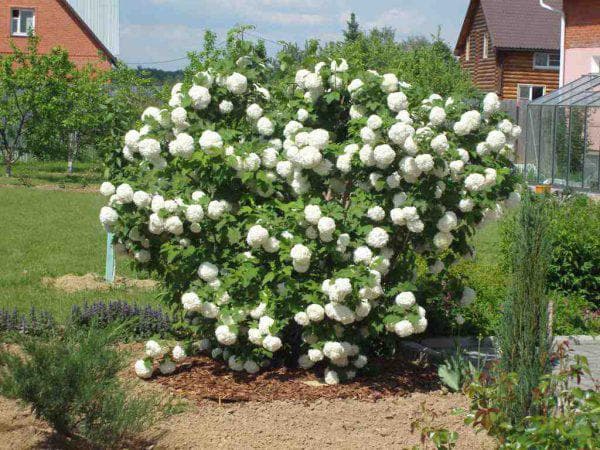

Kalina Buldenezh
Planting viburnum buldenezh
To ensure the healthy development of the shrub, it is necessary to choose the correct planting site. Kalina Buldenezh loves sunny, warm places, protected from strong winds.
The soil should be fertile, humus-humus, alkaline, slightly alkaline or neutral. Sandy substrates are not suitable for growing crops, and clay substrates must be mixed with sand for better water permeability.
The place chosen for growing viburnum should be thoroughly cleaned of weeds, and then well dug up. If the soil in the garden is poor in nutrients, then before planting it is recommended to enrich it with compost (half a bucket), which is mixed with the soil taken from the planting pit.
The size of the hole should be 2 times the size of the root ball. At the bottom of the pit, a drainage layer of broken brick or crushed stone is poured. From above it is covered with a layer of earth.
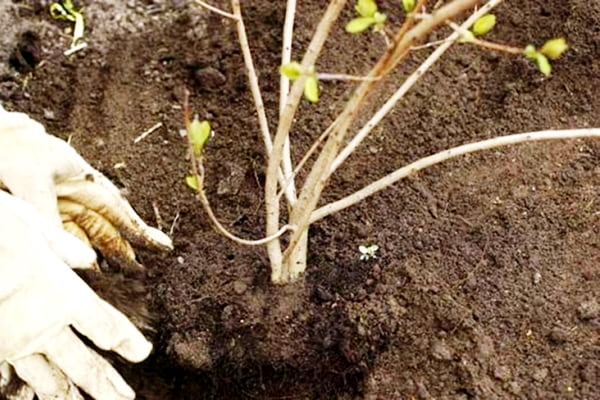

Planting a viburnum seedling
The seedling is carefully lowered into the prepared hole, the root collar is left at ground level or slightly lower, then 1 bucket of water is poured, and when it is absorbed, it is covered with earth and tamped.
The land around is mulched with compost or shredded bark.The main secret of fast rooting is to cut the shoots in half immediately after planting. The procedure stimulates tillering and rapid growth.
Spring planting of trees and shrubs
Seedlings with an open root system are best planted in March-early April or October, and the closed plant system allows planting throughout the season.
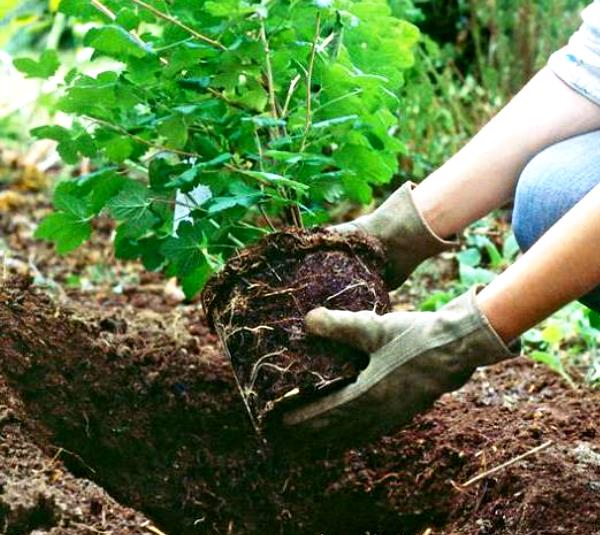

Planting a viburnum seedling with a closed root system
Viburnum buldenezh is transplanted in September-October or in spring. Adult specimens take root hard in a new place, so it is better to transplant only young plants up to 4-5 years of age.
They dig a bush together with an earthen lump and carefully transfer it to a new place in an already finished planting hole. This is the only way to reduce the risk of root damage.
How and when to plant
If single bushes will be planted, then it is worth choosing a place for them on a green lawn. A plant planted near a pond, bench or gazebo looks amazing. Viburnum looks no less beautiful in group plantings. You can give the bush an elegant look if you plant it next to a barberry, a spirea.
Kalina will feel great even when grown in poor soil, in a low-light area. Only in this case will the inflorescences be too small. It is best to plant a bush in the place where the soil is moistened, and the acidity level does not exceed the 6.5 pH mark. Plant the plant in fall or spring.
It is necessary to make a deepening of 40x40 cm in fertile soil, and up to 60 cm in poor soil. Put 30 g of nitrogen, potassium, peat, up to 50 g of phosphorus there. Then deepen the bush to 5 cm.
On the video - a description of the viburnum Buldenezh:
If planting is carried out in spring, then the roots should be cut by 1/3 of the length.
When planting, the bushes should be at a distance of 2 m from each other. At the same time, make sure that the root collar is 3 cm below the surface of the earth. Water the soil under the viburnum thoroughly and cover with mulch from peat or foliage.
It may also be useful for you to learn about how the treatment of roses from aphids with ammonia is carried out, and how else you can protect your flowers is indicated here.
Features of caring for viburnum buldenezh
If the planting site is chosen correctly, then in the future the plant requires little care, since in favorable conditions the bush develops well and the risk of developing diseases is reduced.
Although the plant loves moist soil, regular watering is required only for the first 2 years after planting the seedlings. In subsequent years, only rainfall is enough for adult shrubs, and only during a drought should the bushes be watered abundantly so that the water reaches the lower roots.
In this case, 1 bucket of water is poured under a young bush, 2 buckets under an adult at least 1-2 times a week.
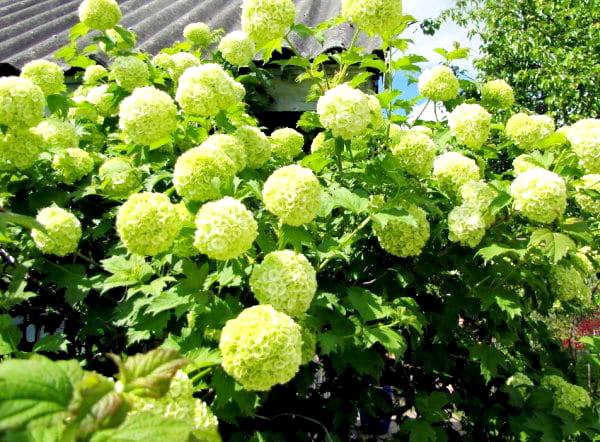

Blooming viburnum buldenezh
Caring for Kalina Buldenezh in spring begins with sanitary pruning of damaged and dried shoots, harvesting last year's foliage, loosening the earth and treating the ground part with antifungal and insecticidal preparations against pathogenic microorganisms and pests that hibernate in cracks in the bark and upper soil layers.
What fertilizers and when to feed garden plants?
Top dressing is carried out in April. The culture's favorite fertilizer is traditional compost, which is poured out in a layer under the bush once or twice a year or once every two years.
In the absence of compost, you can use one of the mineral fertilizers for flowering shrubs with phosphorus and potassium and a low nitrogen content. Summer care for viburnum comes down to weeding, watering, loosening and removing faded inflorescences.
How to care for Kalina Buldenezh in the fall? The old mulch is removed in October, watered well before the onset of frost, young 1-2-year-old seedlings are insulated with fallen leaves or spud with a layer of earth around the trunk.
Caring for Kalina Buldenezh in winter comes down to the timely removal of a large snow layer on large branches after snowfalls in order to prevent their damage.
Possible growing problems
- Collapse of a bush. Reason: wild flowering. Elimination:
- spring pruning of excess branches, shortening of height, cutting of shoots;
- pruning flowering branches;
- tightening the bush with wire in a circle.
- Withering, blackening of leaves and flowers. Reason: powdery mildew or pests: aphids, scale insects, viburnum leaf beetle. Elimination:
- Treatment with insecticide (from pests) before flowering and after flowering, fungicide (from powdery mildew).
- Loss of decorativeness, unattractive appearance after flowering. Elimination:
- Manual pruning or patience: wind and rain will shake off all faded buds from the bush within a week.
Kalina buldenezh is not a medicinal plant, does not produce edible fruits. But it is so beautiful that it should be on every garden plot as food for the soul - for joy, admiration and inspiration. In addition to our article, we suggest watching this video instruction on the proper care and planting for Kalina Buldenezh.
Formation of viburnum buldenezh by pruning
The plant tolerates well any pruning - both sanitary and forming crown. During the first two or three years after planting, the shoots do not need to be shortened or thinned at all, but later this is a desirable procedure.


The dense shrub does not provide sufficient nutrition for all branches, suffers from poor air circulation and a lack of lighting. The best time to prune viburnum is after flowering.
For seedlings grown from cuttings, the first cut is made when the shrub is about four years old. Old shoots are completely cut off, too long are shortened by a quarter. Every five years, you can carry out a general rejuvenation of the bush, shortening the shoots up to 30 cm above the ground.
Benefits of mulching and types of garden mulches
In general, pruning viburnum should be rather superficial, since too radical a cut threatens that the bush will not bloom next year.
Reproduction of viburnum buldenezh by cuttings
The bush reproduces only vegetatively - green or semi-lignified cuttings and layering. Apical cuttings root best. They can be rooted directly in the open field, but in a special light and nutritious substrate.
When grafting, it is important to observe the correct timing of its implementation. Cutting of green cuttings is carried out in late June - early July, for example, after planned pruning.
Shoots should be 1–2 years old, half woody, covered with green bark. Old woody cuttings with brown bark are cut in April.
The lower cut is carried out at a distance of 1-1.5 cm from the base of the leaf and at an angle of 45 ̊, the upper cut over the next pair of buds. The lower leaves on each cutting are cut off.
The sections are dipped into powder that stimulates the formation of roots or kept for 10 hours in a solution of "Heteroauxin" in a dark place, and then buried at a slight angle by 2 cm into the soil of humus, universal garden soil and vermiculite (can be replaced with coarse sand) in a ratio of 1: 3: 1.
How to properly grow a rose from a cutting
Some gardeners recommend laying fertile humus only in the lower layer, and in the upper, 3-5 cm high, leave only sand and soil.
Each stalk is covered with a plastic bottle or transparent film stretched over a frame. The rooting site should be located in areas with diffused light.
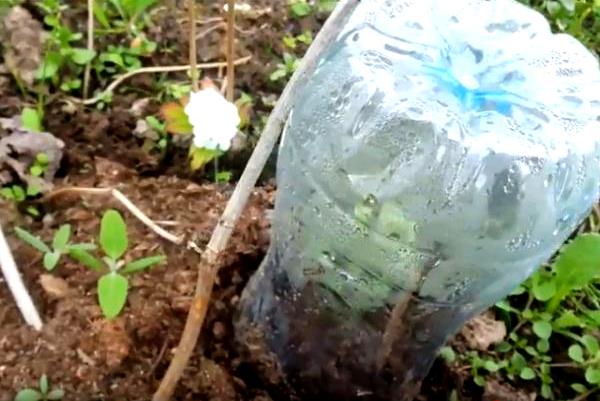

Rooting lignified shanks of viburnum buldenezh
During the rooting process, which takes 2-3 weeks, it is necessary to keep the soil and air moist by spraying the cuttings 3 times a day.
To avoid the development of mold, the cover is periodically removed for ventilation. With the beginning of a new growth, the greenhouse is opened on one side, and a month later it is completely removed.
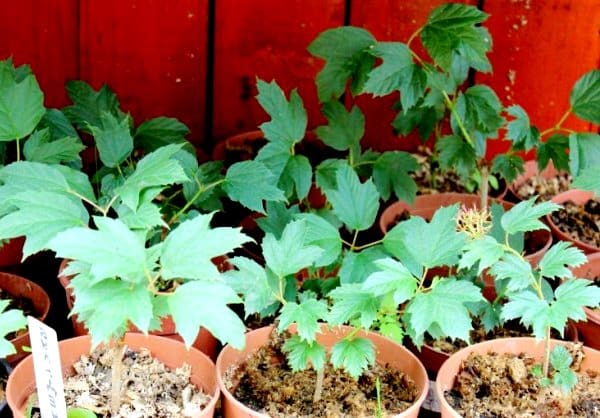

Rooted cuttings
In autumn, after the first frost, the cuttings are covered with needles, fallen leaves or non-woven material, for example, lutrasil. With the onset of spring heat, the shelter is removed.
In April, the cuttings are ready for planting in a permanent place, but it is recommended to leave them to grow for another year in that place, so that the seedlings are fully strengthened.
Propagation by horizontal layers
The easiest way to reproduce viburnum is by horizontal layering. In the spring, the side branches of the bush are bent to the ground and placed in a pre-prepared groove 3-4 cm deep.
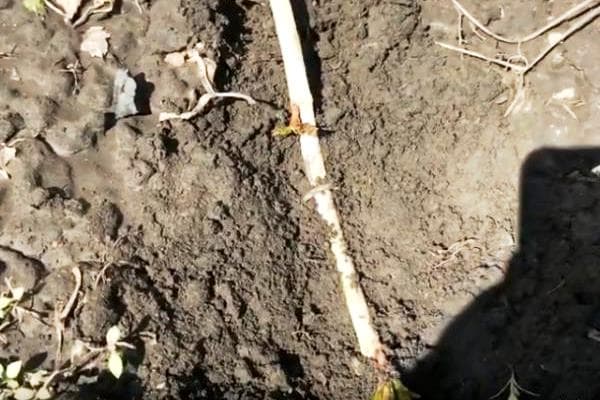

Horizontal rooting of a lateral shoot
Fastened with metal brackets and covered with a mixture of compost and turf in equal proportions. Shoot tips should remain on the surface.
When the new shoots that have developed from the buds reach a length of 15–20 cm, they are covered with soil up to half the height. Hilling is repeated two more times with an interval of two weeks.
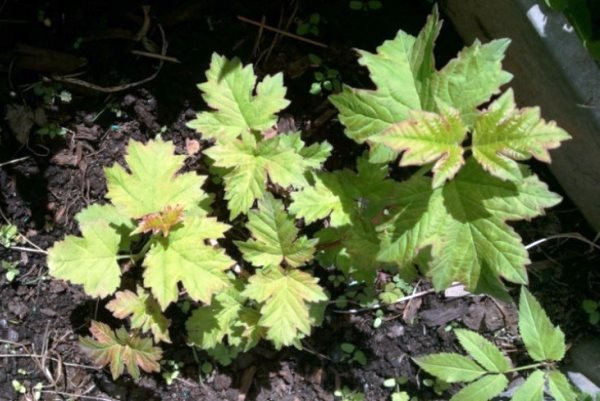

Rooted cut
As a result, the height of the embankment should be 20-25 cm. In early September or spring, young seedlings are separated from the bush and transplanted to a new place.
Reproduction of the viburnum bush buldenezh by vertical layering
In autumn, several lateral, young shoots are cut off, leaving only 2-4 buds. Then they spud them with a high layer of earth. In the spring, when the shoots from the remaining buds grow by 8-10 cm, one more hilling is carried out to about a height of 5 cm.
TOP - 19 unpretentious long-flowering perennials
When the height of the shoots reaches 20-30 cm, they are dug up and pulled with aluminum or copper wire at the base to stimulate root growth.
Then the shoots are cut again by a third. Hilling is repeated after one or two weeks. By the end of summer, vertical layers are taking root. They can be removed immediately from the mother plant or left until next spring.
Problems in growing decorative viburnum
When it comes to diseases, the shrub is quite hardy, although in thickened plantings with high humidity in summer, fungal diseases, for example, powdery mildew or leaf mold (brown spot), can develop. For the purpose of prevention and treatment, fungicidal preparations are used.
The plant needs protection from pests. In late May - early summer, a black louse appears, it affects all shoots and buds, sucking out nutrients from them. However, aphids, viburnum leaf beetle and its leaf beetle caterpillars are the most common pests.


Viburnum leaf beetle caterpillars
In small quantities, insects are successfully destroyed by folk remedies, but in case of mass infestation by pests, chemical insecticides cannot be avoided. Usually 1-2 procedures are sufficient for treatment.
Kalina buldenezh in garden landscaping
The decorative viburnum is a decoration of the autumn garden thanks to its colorful leaves that do not fall off for a long time. The plant is planted in a group composition with low flowering and decorative deciduous shrubs (hydrangea, buddleya, roses, euonymus, spirea and others).
The bush looks spectacular as a large tapeworm against the background of a lawn or surrounded by any squat coniferous crops. The shrub fits perfectly into the atmosphere of the rustic garden and romantic English style.
Flowers planted around the viburnum on a stem should meet its needs, that is, grow well in a sunny place, and prefer moist soil, for example, balsam, begonia, petunia.
Did you like the article? Vote! Rating 5.00 [1 Vote]
Bush formation
Ornamental shrubs need annual pruning. In early spring, before flowering, damaged, weak and dried branches directed to the center of the bush should be removed. The formation of the bush continues at the end of the flowering period. An adult plant should have no more than 6-8 skeletal branches. Therefore, the central part of the shrub is cut out, and the side shoots are shortened.
Melissa - planting and care outdoors
In order for Buldenezh to grow stronger to frost, it must be cut off at the end of August.
Important! If the viburnum does not bloom well, you need to cut off all the stems at a distance of 27-33 cm above the ground.
The Buldenezh bush is a common sight. Not many people know that, if desired, a standard tree can be formed from an ornamental bush. To do this, during the first pruning, you need to remove all the shoots. Leave only one growing straight up. It is important that the vertical stem stretches up to 1.7-2.1 m. Then the apical bud is pinched, thereby stimulating the active formation of lateral shoots. The formation of the crown consists in the timely pinching of the branches. It is necessary to prune shoots as soon as they reach 0.3-0.4 m.
To preserve a beautiful snowy tree, you need to regularly cut out the root growth. It is advisable to thin out the crown every 2-3 years in the spring.
Potential pests
Although the bushes of the viburnum buldenezh are unpretentious, from time to time they are exposed to various ailments. To preserve the beauty of the plant, it is necessary to inspect it regularly.
In early summer, the bushes are damaged by the viburnum leaf beetle. The beetle eats up all the foliage, leaving veins and petioles.
It is necessary to spray the bushes in spring and autumn with Inta Vir, Fufanon or Aktara. The damaged leaves are cut and burned.
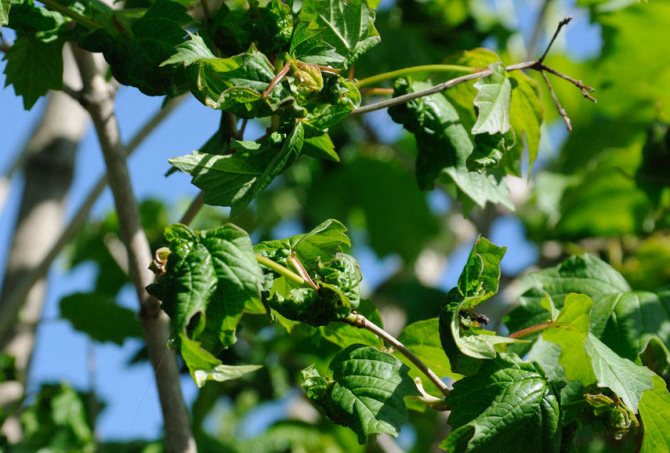

Viburnum aphid is no less dangerous. Small black insects stick around the branches, actively reproduce and suck out all the juices from the viburnum.
Damaged foliage is highly deformed and curled. The first treatment is carried out before bud break, the subsequent ones - as the insects are active. It is necessary to alternate between Karbofos, Arrivo and Fury.
Young bushes are prone to powdery mildew. Prolonged wet weather contributes to the development of the fungus. The leaves are covered with a white bloom, which gradually darkens.
It is not only the green mass that suffers, the infected plants hibernate much worse. All damaged foliage is collected and destroyed, and dry shoots are also disposed of.
Viburnum bushes buldenezh are treated with Topaz or Topsin preparations.
Winter hardiness
When grown in the middle lane, or even more so in the southern regions of the country, no additional shelter is required for the described viburnum bushes. At the same time, in especially harsh winters, it is advisable to insure yourself and insulate the root zone of young seedlings with humus, spreading it out in a thick layer around the bush.
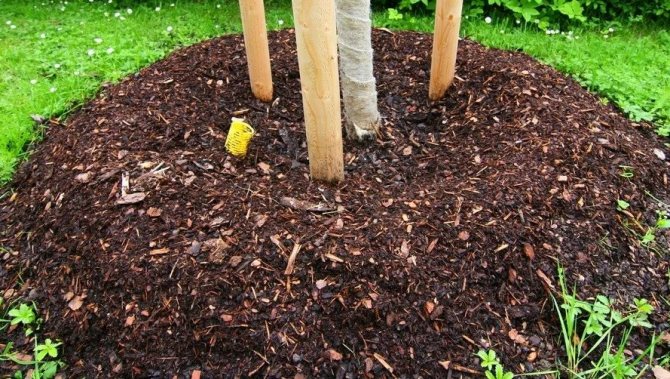

A dense turf lawn has similar protective functions, so it is advisable to preserve the lawn grasses when planting plants. In especially harsh winters, the shoots of Buldenezh viburnum may freeze slightly, but the plant quickly recovers and grows overgrown with new healthy branches.
Location and soil
Usually, Roseum viburnum is planted in open, sunny places, since it blooms worse in the shade. But if you live in a region with hot dry summers, it is better for the shrub to choose a corner of the garden where there will be partial shade at midday. Otherwise, the snow-white flower petals will quickly lose their decorative effect and fly around.
The plant prefers breathable, fertile and moisture-absorbing soil. It tolerates waterlogging much more calmly than a lack of moisture, therefore, if there is a reservoir on the site, there is no better place for the viburnum than the coastal zone. The bush does not like dry sandy soils. On them, the inflorescences are noticeably smaller, and even regular watering does not always manage to correct the situation.
We apply fertilizers
It is important that the hole is well prepared and "filled", that planting and maintenance are performed correctly. Kalina buldenezh growth will be as follows: up to 30 cm per season. Fertilizing under this ornamental shrub begins, as a rule, in the second or third year after planting, since the nutrients laid down in the planting pit by this time run out. The first application of fertilizers, complex or nitrogen-containing, is best done in the spring, during the opening of the buds and the appearance of the first leaves.
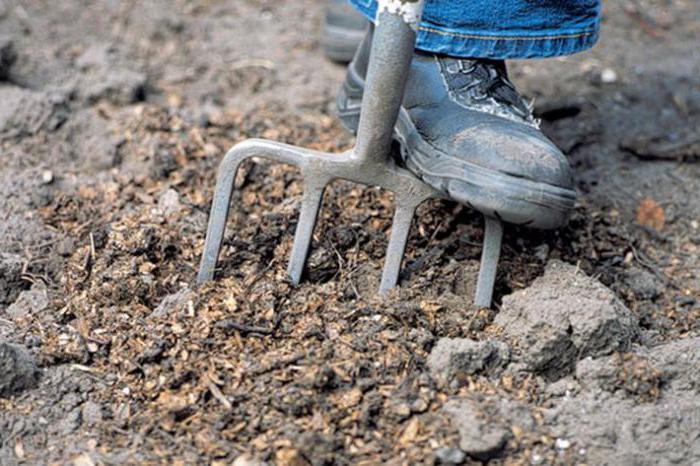

The second time, Boule de Neige is fed with special autumn or potash-phosphorus formulations in the fall, before the shrub sheds its leaves. You can fertilize this variety of viburnum only with organic fertilizers, such as rotted compost or humus, adding about 1-2 buckets under each bush in the spring and slightly digging up the top layer of soil.
Plant of old Europe
When the viburnum "Buldenezh" appeared, it is not known for certain. It is believed that it arose naturally at least 400 years ago and was already spread in the gardens of France and other countries of medieval Europe. Culture came to Russia during the time of Catherine II, where, along with mock orange and roses, it quickly became an indispensable component of a fashionable front garden.
When a plant is not in bloom, it is difficult to distinguish it from an ordinary viburnum. The same tall, spreading bush. The same flexible, slightly drooping branches with three- and five-lobed light green leaves. But during flowering, the difference is enormous.
Buldenezh is covered with dense globular inflorescences, completely consisting of sterile flowers (the culture has no reproductive organs and reproduces only vegetatively.) An adult bush can simultaneously bear from 500 to 700 inflorescences 10-15 cm in diameter. Just imagine how amazing it looks!
At the beginning of flowering, the balls are greenish, but after a few days they become boiling white and retain the “bride's” outfit for 2-3 weeks.
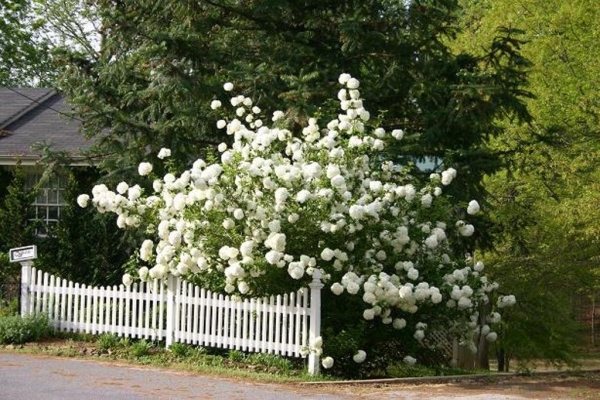

The authorship of the decorative form, called Boul de Neige, is attributed to the famous French breeder Victor Lemoine, the creator of many varieties of mock orange and hydrangea. The second name of the shrub is viburnum Roseum
Interestingly, Boul de Neige ("snowball") is a fairly common name in ornamental gardening. In the same way, in addition to viburnum, one of the varieties of the Bourbon rose is called, a herbaceous terry peony, the oldest variety of rhododendron with snow-white flowers.
What can be grafted on viburnum
Cuttings and eyes of any varietal viburnum can be successfully grafted onto the crown of the common viburnum, or, conversely, using parts of an ordinary variety for grafting into a certain variety. In the case of Buldenezh varieties, this is of particular practical importance, since grafting the crown with a simple viburnum will help to obtain not only beautiful flowers, but also fruits, which, due to the self-infertility of flowers, a “pure” varietal plant is deprived of (usually they are completely edible).
We advise you to find out how to plant viburnum in the spring.
Features and external characteristics
The variety performs purely decorative functions, since it is completely devoid of fruiting. In this regard, Kalina Buldenezh is also called sterile. However, this circumstance does not at all confuse true beauty lovers who grow shrubs on their site and every year admire the graceful white inflorescences of an almost perfect rounded shape.
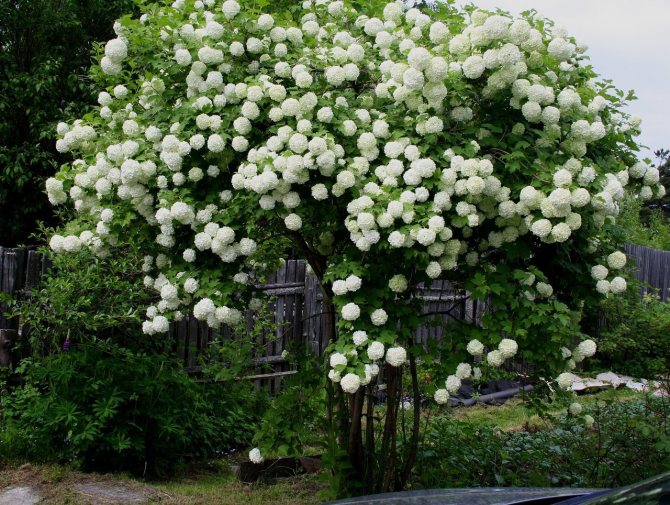

Kalina Buldenezh is a representative of the honeysuckle family, the height of the bush reaches 3.5 m (in the absence of pruning), and the diameter of the chic crown is about 1.5 m. Powerful branches at first grow straight, gradually diverging to the sides and forming a beautiful ball. To give the plant a more presentable look, gardeners cut the branches in such a way as to form a hemisphere.
The main advantage of the variety is the stunning beauty of the inflorescences. The diameter of the balls hanging from the branches can reach up to 15 cm. Flowering begins in May. The emerging pale green flowers are soon replaced by cream or pale pink. Only when they have fully blossomed, they turn dazzling white. The inflorescences are rather large and heavy, which makes the thin branches bend down under their weight. A month later, the flowers dry out and fall off without forming fruit. The life expectancy of the shrub is quite high - the Buldenezh viburnum blooms for about 60 years.
With the arrival of autumn, the leaves acquire a crimson hue, which makes the viburnum stand out from other trees and bushes with their yellowed foliage. There is also a terry variety Buldenezh, which differs from the snow globe only in the shade of the inflorescences - they are pale pink.
How to care
Buldenezh is a shrub that is easy to care for. It is enough to follow a few rules. When choosing a place for a plant, you need to understand that it will need a fairly large space. It must be protected from wind and direct sunlight. Light partial shade is perfect.
Japanese quince shrub - description of the plant and fruits
The snowball also needs pruning, which is carried out in spring or autumn, and helps to form the necessary appearance of the bush. Even if a specific shape is not needed, then for a more lush flowering, pruning is necessary for the bulldozer.
Important! Regularly in the spring, you need to cut off old, dried branches. They will prevent him from fully developing and blooming.
Watering mode
Watering is the most important thing for bulldozing, especially in hot summer conditions. It should be performed regularly so that the earthen lump does not have time to dry out and is constantly moistened. Young seedlings need to be watered especially often. Watering should be carried out in the fall, especially during the first snowless frosts.
Top dressing
Top dressing is not a prerequisite for caring for garden viburnum, but it will not give up organic and mineral complexes. You need to feed the bushes in the spring before the beginning of the flowering period and in the fall before the onset of the first frosts.
Features of care during the flowering period
During the flowering period, it is necessary to thoroughly water the plant and make sure that pests do not appear on it, which are very positive about it. If they appear, the plant must be treated with an insecticide.
Note! From buldenezh it is possible to make beautiful lush bouquets that will delight with their beauty and delicate delicate aroma for up to 10 days.
Preparing the plant for winter
Buldenezh is a fairly frost-resistant plant; it can freeze up only in very harsh winters. To avoid this, you should perform a number of actions in advance:
- in the second half of summer and autumn, do not feed with nitrogenous fertilizers;
- remove young shoots starting in the second half of August;
- gradually reduce watering from September;
- at the end of the leaf fall, make one plentiful watering;
- cover the layer with at least 10 cm layer;
- cover young plants additionally by creating a mini-greenhouse.
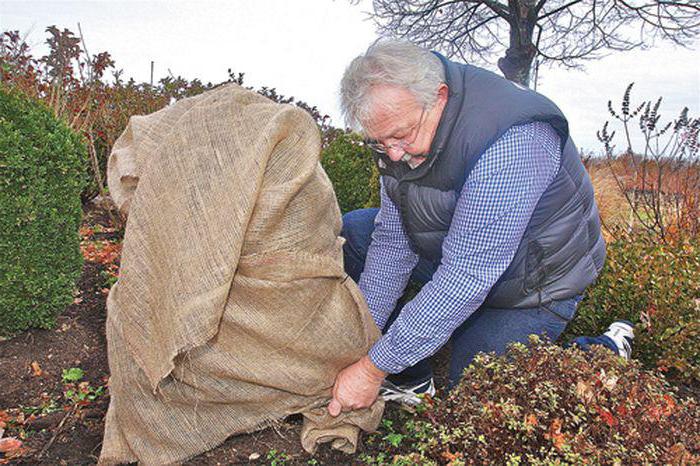

Preparing a Young Bulldog for Winter
Buldenezh is a plant that is ideal for any garden area. It grows rapidly, is distinguished by its unpretentiousness and vitality. Especially pleased with the length of his life It is believed that every man should plant a tree, so why not become a wonderful bulldozer with this tree? Every year it will grow, develop, gain strength, but at the same time it will never stop blooming magnificently, emphasizing the whiteness of its inflorescences with the brightness and juiciness of dense greenery.
Breeding methods of Siberian Buldenezh
Buldenezh, when it fades, does not form ovaries, therefore the seed method of reproduction disappears. The most affordable option is green cuttings. It is suitable for the case when you do not have your own bush, but it grows in a "familiar" area:
- After flowering, as a last resort, you can also during it, cut or ask for twigs.
- Remove thin and flowering tops, cut the cuttings into 3 leaves (buds) each.
- Remove the bottom sheet, shorten the top ones.
- Plant in moist and loose soil, burying the bottom bud.
- Cover the top with half a plastic bottle.
- Open every day, shake off condensation and cover again.
Buldenezh cuttings give roots if they are simply put in water.But, according to some reviews, "water" roots are not viable. It is better for them to appear immediately in the ground.
Another way is easier, but it is for the already established owners of this shrub:
- In spring, bend the branch closest to the ground.
- Place it in the groove, pin and dig in.
- Water or mulch with a good layer of sawdust, straw.
- The next spring, you can separate the finished seedling.
Video: how viburnum is propagated in Khabarovsk
I got the seedling in an incredible way. Was visiting, in the Krasnoyarsk Territory, with relatives. My daughter-in-law at the entrance talked with her grandmother on a bench about this flower, admired the beauty and asked how to take a scion. A local florist told about different methods of reproduction and demonstrated, in her opinion, the most effective one: she pulled out a still young, but full flowering bush along with the roots from the flower bed with her bare hands and gave it away. My daughter-in-law came to me with this story, received a trophy in her outstretched arms, and with a request to give me a bigger bag to wrap up. I saw a sapling with a gorgeous root and three shoots, I was not taken aback and asked to cut off a "piece" for me too. We divided the root with a knife, and we got two seedlings. I think this is the peculiarity of the breeding of Buldenezh in Siberia. The culture is very tenacious, otherwise it would not have taken root in our country.
What types are there
Viburnum fruit varieties are presented in a wide range. And Buldenezh has several subspecies. All of them have high decorative qualities.
Includes viburnum Buldenezh following popular varieties:
- Ordinary. It is considered a sterile form of the common red viburnum. Has a shape that allows you to create interesting compositions. Thanks to this, the common viburnum Buldenezh has gained considerable popularity among summer residents, gardeners and landscape designers.
- Decorative. It differs from the ordinary one in more compact size.
- Roseum. The viburnum Buldenezh Roseum is characterized by terry inflorescences of an unusual shape. Blooming viburnum first has white buds with a green tint, and towards the end they acquire a pale pink tint. The shrub grows over 3 meters. Usually it is used in standard plantings.
Additional Information
- Will there be berries?
Unfortunately, you won't be able to taste the fruits of the viburnum Buldenezh. The flowers of this plant are sterile. Therefore, ovaries cannot form.
- Single landings or compositions?
Kalina Buldenezh is a versatile ornamental plant. The shrub looks great in single plantings. Due to its high resistance to air pollution from exhaust gases, viburnum is used to create hedges. Garden paths and recreation areas are planted with it.
The snow beauty goes well with other flowering shrubs: lilac, mock orange and hydrangea. Viburnum feels great and develops quickly in the neighborhood of barberry, hawthorn and mountain ash plantings.
Additional Information! It is worth noting that Buldenezh forms beautiful landscape compositions with conifers (spruce, thuja), maples, lindens and white-trunk birches.
Viburnum Buldenezh can become a real decoration of any garden. Planting and care in the open field does not require much effort and time from summer residents. In the description of varietal advantages, it is said that Snowball viburnum lives for 50-60 years. How many of them a bush will bloom depends on the patience and efforts of the gardener. Just a little care and attention, and a beautiful ornamental bush will delight the inflorescences surrounding with huge white snowballs for many years.
Buldenezh ideas in landscape design
Viburnum goes well with almost all garden plants.
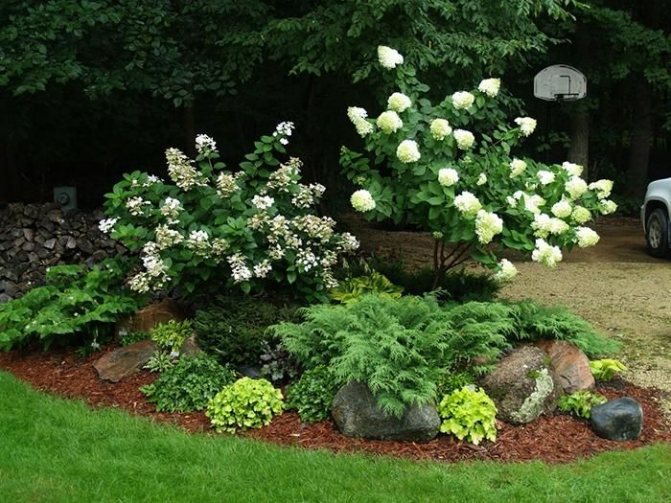

Buldenezh in combination with other plants. Photo:
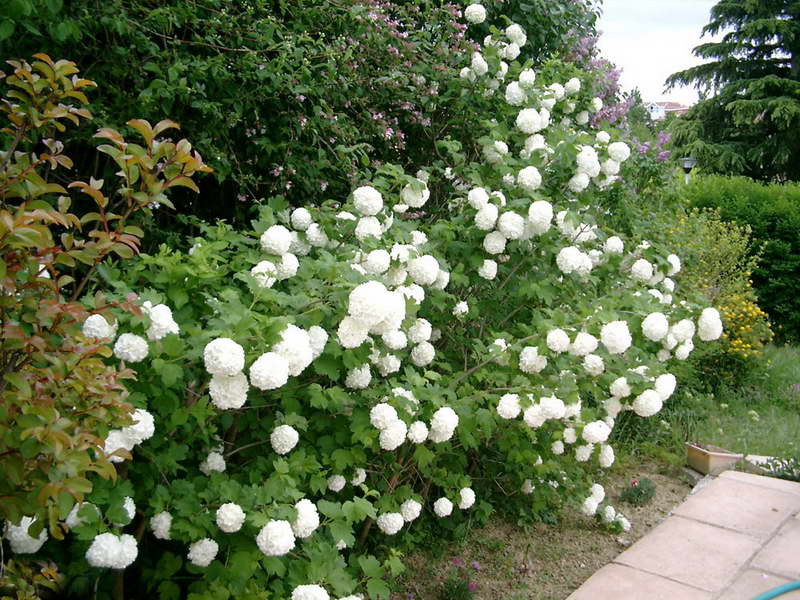

Buldenezh looks great as part of multi-tiered compositions or hedges. Photo: chto-
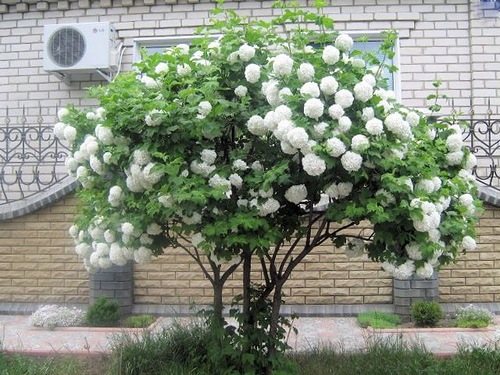

Monoplanting emphasizes the beauty and sophistication of the plant. Photo: info-
Buldenezh is a favorite plant of landscape designers. Looks amazing in any composition, a real garden decoration. The variety is unpretentious. Even a novice gardener is able to grow this incredible beauty on his site. A little care, and the bulldozer will delight the eye for more than a dozen years.
Pest control and winter preparation
Kalina Buldenezh is resistant to diseases, but aphids like to settle on it in any region. Moreover, this pest folds not only the leaves, as in other crops, but also the snow-white petals of the buds. Therefore, from spring to autumn, periodically come closer to the bush and check the leaves. If found infested with aphids, immediately treat with an insecticide: Inta-Vir, Iskra gold, etc. Many people spray with a solution of ammonia: 4 tbsp. l. 10 liters of water, add 4 tbsp. l. liquid soap.
Buldenezh and any bushes intended for cultivation in Siberia are not covered for the winter. The best protection against frost here is a thick blanket of snow. But the hostesses worry about young plants and in the first year or two they throw spruce branches or straw into small new settlers. In the spring, these shelters are removed as early as possible so that the shoots quickly begin to be blown by the breeze and warmed up by the sun.
The reasons why the bush does not bloom
The main reason for the lack of inflorescences is the wrong choice of place for planting.


In the shade, viburnum loses its decorative effect. Dry spring and early summer negatively affect the plant, you will have to monitor the moisture content of the soil.
After a harsh winter, the branches recover for a long time, which also affects flowering.


